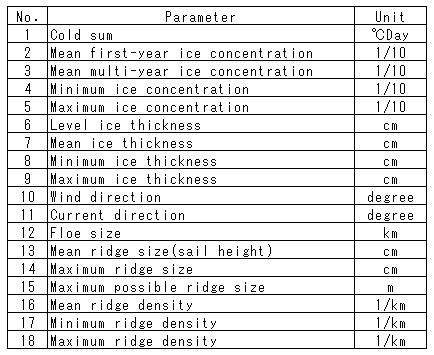2.2 Environmental condition
2.2.1 Summary of environmental condition
The environmental data supplied by the AARI (Brestkin et al.,1998) are the Russian data of the past 40 years, which consist of eighteen parameters shown in Table 2.2.1.
The environmental data are comprised of the monthly average data which were described in each 20 nautical mile segment in specified year along the routes as noted in chapter 2.1.
The voyage route is defined from Yokohama to Hamburg, however, the environmental data were supplied only for the section of the NSR (from the Kara Sea to the Bering Sea). Those data existing out side of the NSR are excluded from the data above. Therefore, those excepted data are assumed as written in Appendix A. The data source are detailed in the following chapter. In order to indicate the approximate trends of 18 parameters in the Table 2.2.1, the yearly average, max., and min. values are shown in Table 2.2.3
Table 2.2.1 Environmental Data

Table 2.2.2 Point on the route and Segment number

Cold sum (Parameter No.1)
The average of monthly temperatures during 1953 to 1991, which were surveyed at fifty polar stations located along the coast of the Arctic Ocean, is used for the cold sum calculation.
The value of each segment was estimated by interpolating observation data of three different polar stations
Ice concentration (Parameter No.2 - No.5)
The ice concentration data were collected and completed based on the observation data from airplanes and satellites. Those data until 1978 were obtained from airplane observation. Satellite observation has been utilized from 1979, Mean first-year ice concentration is the average of the ice concentration in new ice, nilas, young ice, and first year ice. Mean multiyear ice concentration is the average of the ice concentration in old ice, second-year ice, and multi-year ice.
前ページ 目次へ 次ページ